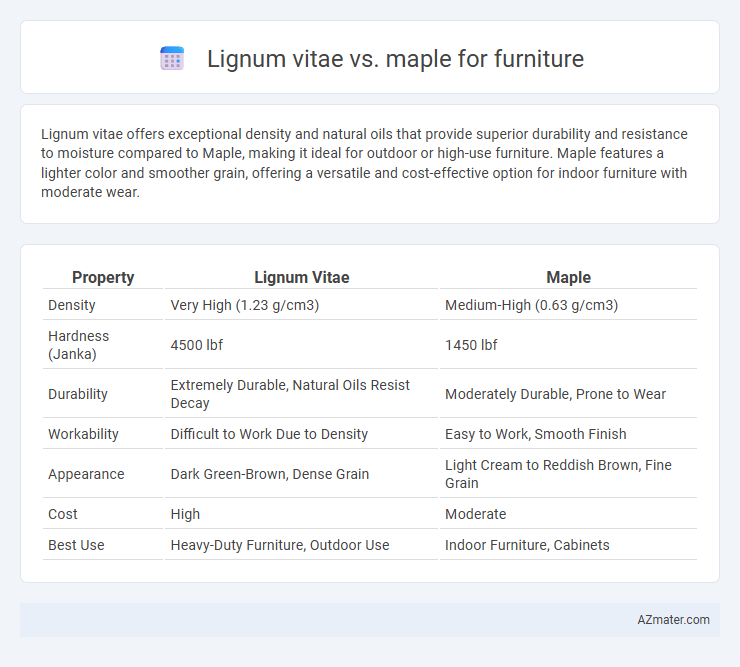Lignum vitae offers exceptional density and natural oils that provide superior durability and resistance to moisture compared to Maple, making it ideal for outdoor or high-use furniture. Maple features a lighter color and smoother grain, offering a versatile and cost-effective option for indoor furniture with moderate wear.
Table of Comparison
| Property | Lignum Vitae | Maple |
|---|---|---|
| Density | Very High (1.23 g/cm3) | Medium-High (0.63 g/cm3) |
| Hardness (Janka) | 4500 lbf | 1450 lbf |
| Durability | Extremely Durable, Natural Oils Resist Decay | Moderately Durable, Prone to Wear |
| Workability | Difficult to Work Due to Density | Easy to Work, Smooth Finish |
| Appearance | Dark Green-Brown, Dense Grain | Light Cream to Reddish Brown, Fine Grain |
| Cost | High | Moderate |
| Best Use | Heavy-Duty Furniture, Outdoor Use | Indoor Furniture, Cabinets |
Introduction to Lignum Vitae and Maple
Lignum vitae, known for its exceptional density and natural oils, offers superior durability and resistance to decay, making it ideal for heavy-use furniture. Maple, a hardwood prized for its fine, uniform grain and excellent workability, excels in creating smooth, polished surfaces with a light, warm tone. Choosing between Lignum vitae and Maple depends on the balance of strength requirements and desired aesthetic appeal in furniture design.
Botanical Origins and Characteristics
Lignum vitae, derived from the genus Guaiacum native to the Caribbean and the northern coast of South America, is renowned for its exceptionally dense and oily hardwood, offering natural resistance to wear and decay. In contrast, Maple, primarily sourced from the Acer species found across North America and Europe, features a fine, even grain with a smooth texture that is easier to work with and finishes well for furniture applications. The botanical differences influence their hardness, moisture resistance, and aesthetic qualities, making Lignum vitae ideal for heavy-duty, durable furniture and Maple preferred for elegant, finely crafted pieces.
Physical Properties Comparison
Lignum vitae exhibits exceptional hardness with a Janka rating of approximately 4,500 lbf, significantly surpassing maple's 1,450 lbf, making it highly resistant to dents and wear. Its natural oils provide excellent resistance to moisture and decay, whereas maple is more prone to swelling and minor surface damage without proper treatment. Additionally, Lignum vitae's density ranges from 1,260 to 1,370 kg/m3, far denser than maple's 700 to 750 kg/m3, contributing to its superior durability but also increased weight for furniture applications.
Aesthetic Appeal: Color and Grain Patterns
Lignum vitae boasts a rich, dark brown color with occasional greenish hues, featuring a dense, oily grain that creates a smooth, lustrous finish ideal for luxurious, traditional furniture. Maple offers a lighter, creamy color palette ranging from pale white to light reddish-brown, with a fine, consistent grain pattern that enhances modern, minimalist furniture styles. The contrasting aesthetics between Lignum vitae's dramatic hues and Maple's subtle brightness cater to diverse design preferences in high-quality wood furniture.
Durability and Lifespan
Lignum vitae is renowned for its exceptional durability and natural resistance to decay, making it one of the hardest and densest woods ideal for long-lasting furniture. Maple, while also durable, offers moderate hardness and tends to be more susceptible to wear over time compared to the ultra-dense lignum vitae. Lignum vitae furniture can often last several decades with minimal maintenance, whereas maple furniture typically requires more care to maintain its lifespan and appearance.
Workability and Crafting Ease
Lignum vitae offers exceptional durability and natural oils that reduce friction, making it highly workable for intricate furniture details despite its extreme hardness. Maple is softer and easier to carve or shape, providing smoother sanding and finishing processes that benefit craftsmen aiming for precision. The dense grain of lignum vitae demands sharper tools and more effort, whereas maple's consistent grain structure simplifies crafting and reduces tool wear.
Common Uses in Furniture Making
Lignum vitae is prized in furniture making for its extreme hardness, natural oils, and resistance to wear, making it ideal for heavy-duty applications like workbenches and tool handles. Maple, known for its fine grain and durability, is commonly used in crafting smooth tabletops, chairs, and cabinetry that require a balance of strength and aesthetic appeal. Both woods offer versatility, with lignum vitae favored for high-strength tasks and maple preferred for detailed, decorative furniture pieces.
Environmental Sustainability and Sourcing
Lignum vitae, known for its exceptional density and natural resistance to decay, is sourced primarily from slow-growing tropical trees native to the Caribbean and Central America, raising concerns about overharvesting and habitat depletion. In contrast, maple, especially when harvested from sustainably managed North American forests, offers a more environmentally sustainable option due to its faster growth rates and better-established reforestation practices. Choosing furniture made from certified sustainable maple reduces ecological impact while supporting responsible forestry, unlike Lignum vitae whose limited supply often leads to unsustainable extraction.
Cost and Market Availability
Lignum vitae is significantly more expensive than maple due to its rarity and slower growth, often costing several times more per board foot. Maple is widely available and more affordable, making it a popular choice for furniture manufacturers seeking cost-effective and consistent supply. Market availability favors maple, which benefits from sustainable harvesting and large-scale commercial plantations, whereas lignum vitae is limited by its protected status and scarce natural sources.
Choosing the Right Wood for Your Furniture
Lignum vitae offers exceptional hardness and natural oils that provide superior durability and resistance to decay for long-lasting furniture, making it ideal for high-wear pieces like tables and chairs. Maple, known for its light color, fine grain, and workability, is favored for versatile designs and smooth finishes in indoor furniture such as cabinets and dressers. Choosing between Lignum vitae and Maple depends on the balance between durability needs and aesthetic preferences, with Lignum vitae excelling in toughness and Maple in adaptability and appearance.

Infographic: Lignum vitae vs Maple for Furniture
 azmater.com
azmater.com